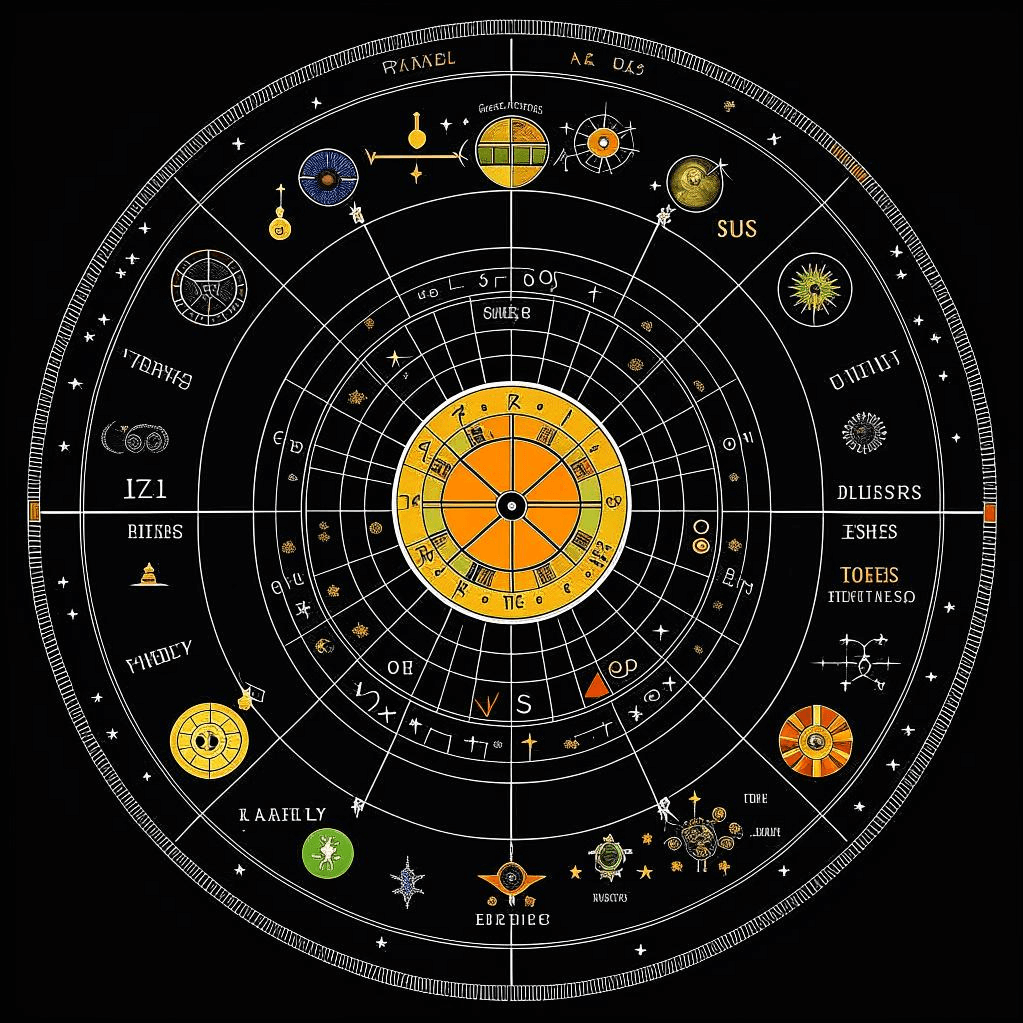Astrology has been a fascinating and influential practice in many cultures throughout history. It involves studying the positions and movements of celestial bodies to gain insight into human behavior and events. One important aspect of astrology is the concept of astrology houses, which divide the sky into different sections to represent different areas of life. There are various house systems used in astrology, and one of them is the Porphyry House System. In this article, we will explore the significance of astrology and delve into the mysteries of the Porphyry House System, understanding its origins, how it works, and its interpretation and application in astrology.
Contents
I. Understanding Astrology House Systems
II. Origins and History of the Porphyry House System
III. How the Porphyry House System Works
IV. Interpretation and Application of the Porphyry House System
V. Debates and Controversies Surrounding the Porphyry House System
VI. Conclusion
I. Understanding Astrology House Systems

Astrology house systems are like different ways of dividing up the sky to interpret an astrological chart. Each house represents a different area of life, like relationships, career, or health. There are several house systems used in astrology, but they all serve the same purpose – to give us a deeper understanding of ourselves and our lives.
Think of the sky as a big circle, and the planets and stars are scattered within this circle. The house systems help us determine where these planets and stars fall in our individual charts. This placement gives us clues about how these cosmic energies influence different aspects of our lives.
Different house systems use different methods to divide up the sky. Some common house systems include the Placidus, Koch, and Equal House systems. Each system has its own way of calculating the size and position of the houses.
House systems are crucial in astrology because they provide a framework for interpreting the planets’ influence in our lives. For example, if a planet is in the 7th house, it may indicate a focus on relationships or partnerships. If it’s in the 10th house, it could suggest a strong emphasis on career and public image.
Understanding house systems helps astrologers interpret charts more accurately and provide insights into different areas of life. By studying the houses, we can gain a better understanding of ourselves, our strengths, challenges, and potentials.
II. Origins and History of the Porphyry House System


The Porphyry House System was created by a philosopher named Porphyry. He lived a long time ago, in the third century AD. Back then, astrology was a popular practice, and people used different ways to divide the sky into sections called houses.
Porphyry thought of a new way to divide the houses in astrology charts. He wanted to make it more accurate and precise. So, he came up with the Porphyry House System. This system became quite popular and was used by many astrologers.
The Porphyry House System was developed during a time when astrology was flourishing. It was influenced by the knowledge and ideas of ancient Greek philosophers. Porphyry’s system was one of the many house systems used in astrology, but it stood out for its unique approach.
Compared to other popular house systems, the Porphyry House System used a simple and straightforward calculation method. It divided the houses based on the degree of the Ascendant, which is the sign rising on the eastern horizon at the time of birth.
Over the years, the Porphyry House System gained recognition and was widely used by astrologers. It became a valuable tool for interpreting astrological charts and understanding a person’s life and destiny.
However, it is important to note that the Porphyry House System is not the only house system in astrology. There are other systems, such as the Placidus and Koch systems, that have their own unique ways of dividing the houses.
Despite its popularity, the Porphyry House System has also faced some criticisms and debates. Some astrologers argue that it may not always accurately represent the reality of a person’s life. However, many astrologers still find value in using the Porphyry House System and believe it can provide meaningful insights into a person’s astrological chart.
In conclusion, the Porphyry House System was created by a philosopher named Porphyry in the third century AD. It became popular among astrologers for its accuracy and simplicity in dividing the houses in astrological charts. While it has its critics, the Porphyry House System continues to be used and valued by many astrologers today.
III. How the Porphyry House System Works


The Porphyry House System is a method used in astrology to determine the placement of planets and other celestial bodies in specific houses of an astrological chart. Here’s a simplified explanation of how the Porphyry House System works:
1. Calculation Method: The Porphyry House System divides the celestial sphere into twelve equal sections, called houses. The Ascendant (the point that rises on the eastern horizon at the time of birth) is used as the starting point for the calculations. The distance between the Ascendant and the Midheaven (the point directly above the birthplace) is divided into three equal parts, creating three intermediary points.
2. House Placement: The first house begins at the Ascendant and extends to the first intermediary point. The second house starts from the first intermediary point and extends to the second intermediary point, and so on, until the twelfth house ends at the Midheaven. Each house represents different areas of life, such as personality, finances, relationships, and career.
3. Key Features: The Porphyry House System is known for its simplicity and ease of use. It maintains the same house size throughout the chart, making it straightforward to interpret the placement of planets and other celestial bodies within each house. This system also preserves the natural order of the zodiac signs, which can be helpful in understanding the astrological influences.
4. Advantages and Limitations: The Porphyry House System is widely used due to its simplicity and historical significance. It provides a clear understanding of the placement of planets and their influence on different areas of life. However, one limitation is that it doesn’t consider the curvature of the Earth, which can affect the accuracy of house placements in certain latitudes.
By using the Porphyry House System, astrologers can gain insights into how the planets and celestial bodies interact with different areas of an individual’s life. It offers a practical and accessible approach to interpreting astrological charts and understanding the mysteries of astrology.
IV. Interpretation and Application of the Porphyry House System


In simple terms, the Porphyry House System is a way of understanding and interpreting astrological charts. It helps us analyze the different areas of our lives and how they are influenced by the planets and other celestial bodies.
When using the Porphyry House System, we divide the astrological chart into twelve sections called houses. Each house represents a different aspect of our lives, such as relationships, career, and health. The Porphyry House System uses a specific calculation method to determine the size and placement of each house.
To interpret an astrological chart using the Porphyry House System, we look at the planets and other celestial bodies in each house. This gives us insights into how these areas of our lives are affected by the energies and influences of the planets.
For example, if we have the planet Venus in the seventh house, which represents relationships, it suggests that our romantic partnerships are important to us and may play a significant role in our lives.
By understanding the significance of each house in the Porphyry House System, we can gain a deeper understanding of ourselves and our experiences. This system allows us to make connections between the planetary influences and the different areas of our lives.
It’s important to note that the Porphyry House System is not the only way to interpret astrological charts. There are other house systems that astrologers use, each with its own unique approach. However, the Porphyry House System has been widely used and studied throughout history, making it a valuable tool for astrologers.
In conclusion, the Porphyry House System provides a framework for interpreting astrological charts and understanding how the planets influence different areas of our lives. By using this system, we can gain insights into ourselves and make more informed decisions about our future.
V. Debates and Controversies Surrounding the Porphyry House System


The Porphyry House System, like any other astrology system, has faced its fair share of debates and controversies. Here are some of the main points of contention:
Criticisms and challenges:
– Some astrologers argue that the Porphyry House System is too simplistic and does not accurately reflect the complexities of a person’s life.
– Critics claim that the system relies too heavily on the Midheaven and Ascendant points, neglecting other important factors in a chart.
– There is also a concern that the Porphyry House System may not be suitable for certain chart configurations or astrological techniques.
Alternative viewpoints:
– Other house systems, such as the Placidus or Equal House systems, have their own loyal followers who argue that they provide more accurate and nuanced interpretations.
– Some astrologers prefer to use multiple house systems simultaneously to gain a broader perspective on a chart.
Response and defense:
– Supporters of the Porphyry House System argue that its simplicity is its strength, making it accessible and easy to understand for beginners.
– They believe that the system’s focus on the Midheaven and Ascendant provides valuable insights into a person’s public image and personal identity.
– Advocates also argue that the Porphyry House System can be used in conjunction with other techniques and systems to create a more comprehensive analysis.
In conclusion, the Porphyry House System, like any astrology system, has its critics and supporters. It is important for astrologers to consider different perspectives and experiment with various house systems to find the approach that resonates best with them.
VI. Conclusion
In conclusion, the Porphyry House System is a method used in astrology to interpret astrological charts. It was developed by the philosopher Porphyry and has a long history in astrology. The system calculates the placement of the houses in a chart based on the Ascendant and divides the chart into twelve equal sections. It has its own unique features and advantages, but also some limitations.
Using the Porphyry House System, astrologers can analyze different areas of a person’s life and understand their significance. Each house represents a specific aspect of life, such as relationships, career, and health. By studying the placement of planets and other celestial bodies within these houses, astrologers can gain insights into a person’s personality and future events.
However, there are debates and controversies surrounding the Porphyry House System. Some critics argue that other house systems may be more accurate or relevant. It’s important to consider alternative viewpoints and understand the limitations of any astrological system.
In conclusion, the Porphyry House System is a valuable tool for astrologers to unlock the mysteries of astrology. While it may not be the only house system used, it offers unique insights and interpretations. As with any astrological practice, it’s important to approach it with an open mind and continue exploring different methods to deepen our understanding of the cosmos and ourselves.






